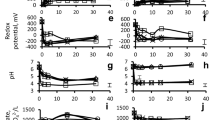Abstract
The contamination and resulting degradation of water coursesby effluents from abandoned and active mines is a world-wideproblem. Traditional methods of remediating the dischargesfrom mines involve the addition of chemicals and the utilisationof artificial energy sources. Over the last 15–20 years passivetreatment systems have been developed that harness naturalchemical and biological processes to ameliorate the potentiallytoxic effects of such discharges. There are many different typesof passive system, including compost wetlands, reducing andalkalinity producing systems (RAPS), permeable reactive barriersand inorganic media passive systems. Different waste materialscan be utilised as reactive media within each of these systems,dependent upon the type of mine water and treatment technology.In many cases the reactivity of these recycled waste materialsis key to the remedial performance of these systems. The materialsused may be organic (e.g., composts) or inorganic (e.g., blast furnaceslag) and where possible are sourced locally in order to minimisetransport costs. The remediation of mine waters in itself canproduce large quantities of waste products in the form of ironoxide sludge. Potential uses of this material in the productionof pigments and in the treatment of phosphate contaminatedwaters is also currently under investigation.
The exploitation of what are traditionallythought of as waste materials within treatmentsystems for polluted waters is an expandingtechnology which provides great scope for recycling.
Similar content being viewed by others
References
Amos, P. W. and Younger, P. L.: 2003, 'Substrate Characterisation for a Subsurface Reactive Barrier to Treat Colliery Spoil Leachate', Water Research 37, 108–120.
Benner, S. G., Blowes, D. W., and Ptaceck, C. J.: 1997, 'A Full-Scale Porous Reactive Wall for Prevention of Acid Mine Drainage', Ground Water Monitoring and Restoration 17, 99–107.
Chang, I. S., Shin, P. K., and Kim, B. H.: 2000, 'Biological Treatment of Acid Mine Drainage under Sulfate-Reducing Conditions with Solid Waste Materials as a Substrate', Water Research 34, 1269–1277.
Gavaskar, A. R., Gupta, N., Sass, B. M., Janosy, R. J., and O'Sullivan, D.: 1998, Permeable Barriers for Groundwater and Reclamation, Springer, Heidelberg, 435 pp.
Heal, K., Younger, P. L., Smith, K., Glendinning, S., Quinn, P., and Dobbie, K.: 2002, 'Novel Use of Ochre from Mine Water Treatment Plants to Reduce Point Source and Diffuse Phosphorus Pollution', in C. Nuttall (ed.), Proceedings of the National Conference, Mine Water Treatment: A Decade of Progress, University of Newcastle upon Tyne, Newcastle, pp. 60–68.
Hedin, R. S., Nairn, R. W., and Kleinmann, R. L. P.: 1994, Passive Treatment of Polluted Coal Mine Drainage, U.S. Bureau of Mines Information Circular 9389, US Department of the Interior, Washington, DC, 35 pp
Hedin, R. S.: 2002, 'Recovery of Marketable Iron Oxide from Mine Drainage', in C. Nuttall (ed.), Proceedings of the National Conference, Mine Water Treatment: A Decade of Progress, University of Newcastle upon Tyne, Newcastle, pp. 1–7.
Jarvis, A. P. and Younger, P. L.: 2001, 'Passive Treatment of Ferruginous Mine Waters Using High Surface Area Media', Water Research 35, 3643–3648.
Kuo, S.: 1986, 'Concurrent Sorption of Phosphate and Zinc, Cadmium, or Calcium by a Hydrous Ferric Oxide', Soil Science Society of America Journal 50, 1412–1419.
Parfitt, R. L.: 1989, 'Phosphate Reactions with Natural Allophone, Ferrihydrite and Goethite', Journal of Soil Science 40, 359–369.
PIRAMID: 2003, in P. L. Younger and L. C. Batty (eds.), Final report to the European Commission.
Younger, P. L.: 1998, 'Design, Construction and Initial Operation of Full-Scale Compost-Based Passive Systems for Treatment of Coal Mine Drainage and Soil Leachate in the UK, in Proceedings of the International Mine Water Association Symposium on “Mine Water and Environmental Impacts”, Johannesberg, South Africa, 7th-13th September 1998, Volume II, pp. 413–424.
Younger, P. L., Banwart, S. A., and Hedin, R. S.: 2002, Mine Water: Hydrology, Pollution, Remediation, Kluwer Academic Publishers, Dordrecht.
Author information
Authors and Affiliations
Rights and permissions
About this article
Cite this article
Batty, L.C., Younger, P.L. The Use of Waste Materials in the Passive Remediation of Mine Water Polution. Surveys in Geophysics 25, 55–67 (2004). https://doi.org/10.1023/B:GEOP.0000015387.12390.ab
Issue Date:
DOI: https://doi.org/10.1023/B:GEOP.0000015387.12390.ab




